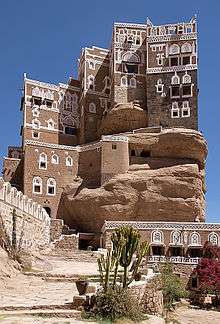Ashrafiya Mosque
Madrasa and Mosque of Al-Ashrafiya or Ashrafiya Mosque (Arabic: جامع ومدرسة الأشرفية) is a historical madrasa-mosque in the old part of the city of Taiz, Yemen. It is located at the foot of Mount Sabr in the southwestern part of the city in a neighborhood named Ashrafiya.[1] It was built in 1275 and opened in 1382 by Sultan Ashraf Ismail bin Abbas of Rasulid dynasty. In addition to the prayer hall, the mosque is attached with a madrasa and the shrines of a number of the Rasulid sultans. It is considered as one of the two most beautiful mosques in Taiz, along with Mudhaffar Mosque, and one of the most important centers in Islamic history of Yemen.[2][3]
| Madrasa and Mosque of Al-Ashrafiya جامع ومدرسة الأشرفية | |
|---|---|
_Al-Ashrafiya.jpg) Entrance | |
| Religion | |
| Affiliation | Islam |
| Region | West Asia |
| Status | Active |
| Location | |
| Location | Taiz, Yemen |
| Geographic coordinates | 13°34′08″N 44°00′32″E |
| Architecture | |
| Type | Mosque, Madrasa |
| Style | Islamic |
| Completed | 1275 2004-2015 (restoration) |
| Specifications | |
| Dome(s) | 9 |
| Minaret(s) | 2 |
| Materials | stone, gypsum, plaster |
Description
_Al-Ashrafiya.jpg)
The prayer room is located in the northern part of the compound. The main part of this mosque occupies a rectangular area from east to west for 25.40m and width from north to south for 7.65m. The central area of the prayer house is covered by a tall dome decorated with colorful motifs. The square of the dome is surrounded by two hallways, each covered with four small domes.[4]
Madrasa
The madrasa of Ashrafieh was built with stone and plaster and was one of the most important centers of education of the Shafi'i Islamic school of thought. The school has a library with a number of books regarding variety of subjects. It has four entrances, and on top of the main entrance there's an inscription written as following:
Order of the building of this blessed school by our lord and king Sultan Al-Sayyid by the terms of the honorable king of the country and the religion Ismail bin Abbas bin Ali bin Dawud bin Yusuf God gave his kingdom and victory.
Perservation status
The mosque is facing degradation which caused by a number of factors, including seismic movements, geological instability, rainwater from the rooftop causing both physical and chemical damages, and anthropogenic degradation. Conservation effort took consolidation of walls and restoration of wall paintings.[5]
Gallery
 Domes of al-Ashrafiya Mosque.
Domes of al-Ashrafiya Mosque. Three of the domes of the Ashrafiya Mosque
Three of the domes of the Ashrafiya Mosque the Ashrafiya Mosque
the Ashrafiya Mosque
See also
References
- جامع الأشرفية
- Kelly, Mike. My Shadow on the Clouds. Lulu Press. p. 119.
- مسجد الأشرفية في اليمن.. لوحة فنية أبدعها “العصر الرسولي”
- المدرسة الأشرفية شاهد حي على عز مدينة تعز
- "IVBC, retrieved May 28, 2017". Archived from the original on July 29, 2017. Retrieved May 28, 2017.

